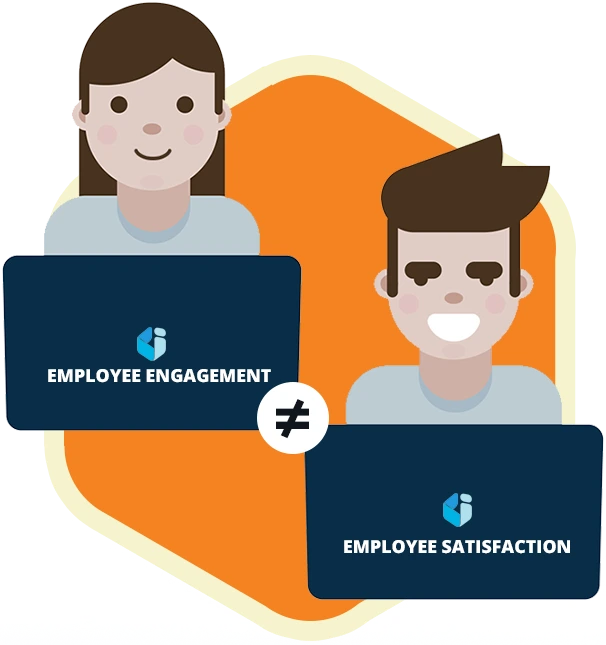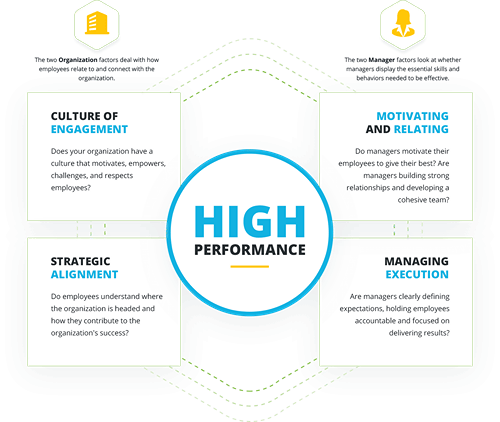
What is the meaning of Employee Engagement?
It is defined by the extent to which contributors feel passionate about their jobs, are committed to the organization, and put discretionary effort into their work.
This is not the same
as satisfaction
What is Employee Satisfaction?
It is defined by how happy or content your contributors are. It does not address their deeper level of motivation, involvement, or emotional connection to the organization. For some, being satisfied means collecting a paycheck while doing as little work as possible.
Job satisfaction is important for other reasons. It has an impact on a person's work lifecycle, affecting retention and turnover. This is especially true in situations where low satisfaction is due to low compensation.
When organizations focus on how to improve satisfaction, changes might not lead to increased performance. The conditions that make workers "satisfied" with their jobs can reveal ways to improve and challenge the status quo.


Understand Your Staff's Experiences
Engagement goes beyond perks, activities, or one-time initiatives. It is woven throughout a contributor's entire journey, from recruitment and onboarding to exit interviews. It involves how employees think, act, and collaborate at work, shaping their overall experience. Driven by daily interactions at work, engagement is key for sustained excellence.
What does that look like?
They seek feedback from management. They excel in communication. They expect everyone to be held accountable for delivering results. They find meaning in their team and at work. They express interest in chances for growth. They are innovative and comfortable with challenges. Conversely, low performers avoid accountability, cling to the status quo, and resist change.
The conditions that make some "satisfied" with their jobs are the same conditions that frustrate high performers.
Why is employee
engagement important?
It has a direct impact on business outcomes.
Engaged workers understand their role and purpose within the company, creating alignment. This alignment improves decision-making. It drives growth and innovation. Engaged organizations outperform competitors, with higher earnings, quicker recovery after setbacks, and reduced absenteeism, stress, and burnout. They also benefit from stronger leadership and increased customer satisfaction.
What are the benefits of employee engagement?
Increased productivity, creativity, innovation, employee retention, and loyalty.
Improved relationships, communication, collaboration, customer satisfaction, and organizational culture.
Reduced absenteeism and turnover costs.
These are just a few benefits of engaged workers. Successful companies are future-focused. They treat talent as scarcer than capital.

These statistics show the benefits of workforce engagement:
The impact of employee engagement on performance is visible in the net income of an organization.
Increases:
- 22% in Profitability
- 21% in Productivity
- 22% in Customer Ratings
Decreases:
- 41% in Quality Defect
- 48% in Safety Incidents
- 37% in Absenteeism
How to Increase Employee Engagement
With over twenty years of experience, we have found that employee engagement stems from intentional, strategic practices embedded in the culture of each organization. It is built through daily actions that drive success. Start by improving the employee experience, focusing on factors like belonging, autonomy, accountability, communication, recognition, and opportunity.
Belongingness
Do not underestimate the power of belonging at work. Create a safe, inclusive work environment. People need to feel comfortable expressing themselves. Their contributions must have value. They should be confident in performing their roles. Build belonging at work and demonstrate commitment to it through meaningful benefits and initiatives. Organizations must have a structure that supports this.
Empowerment and autonomy
The level of autonomy in decision-making, task execution, and role responsibilities shapes these values. Empower your employees by giving them the freedom to manage their own workloads. Encourage them to prioritize innovation and experimentation. Provide opportunities and challenging tasks that promote personal growth.
Accountability
This is about delivering on commitment. When people are held accountable for their work, the organization establishes a culture of trust. There is an expectation that everyone will do their jobs. To boost accountability, set clear expectations, address problems, handle disagreements gracefully, and discuss both professional and personal goals. Make accountability a habit.
Communication
Strategic, multi-directional communication is part of a healthy organization culture. Successful internal communication increases teamwork and productivity. This improves the worker experience. Examples of internal communication strategies include one-on-one conversations, meetings, company emails, employee apps, and intranet forums. If it matters, measure it. Establish metrics to determine the effectiveness of the internal communication plan.
Recognition
Meaningful recognition and fair compensation matter. Acknowledge and reward staff for their contributions and achievements. Pay them well. Provide benefits that matter. Show gratitude. Types of recognition include bonuses, written thank you notes, verbal praise at a meeting, formal recognition (picking top performers), and tenure anniversaries. Publish achievements on community platforms, the organization website, and in a newsletter. Recognition helps people find meaning with their work and the organization.
Growth opportunities and talent development
Provide opportunities, activities, and programs for people to grow and learn. Great leaders know the personal and professional goals of everyone on their team. They find ways to align the goals of each employee with the mission of the organization. This not only improves the employee experience, but also attracts top talent. These are tangible benefits to the organization. Explore many ways to develop your teams. Bring in speakers and industry experts. Create a library area with relevant materials. Get your senior staff active and involved with mentorship and returnship programs. Provide employees with the chance to attend workshops, conferences, and online classes.
Work-Life Balance (or Work-Life Integration)
Work-life balance keeps work and life separate, while work-life integration (WLI) recognizes their overlap. Your organization does not need to choose between the two, but should value the personal lives of employees. Encourage breaks, offer flexible hours, and support staff during stressful times with actions like in-house mental health appointments, mandatory break times, and lunchtime yoga or meditation. A healthy work environment starts by preventing burnout. By prioritizing work-life balance and integration, you help build a healthier workplace culture.
Best practices for effective employee engagement include developing strategies aimed at improving the worker experience. Engagement efforts must include sustainable programs, ideas, and initiatives. It boils down to data-driven decision making.
Assess the commitment, motivation, and perceptions people have of the company. Take a measurement of your organization's engagement levels. Identify what motivates and what disengages your people. Then take action to improve your company culture and employee performance. Here's how.
How to measure employee engagement:
Surveys offer a data-driven and effective method to measure employee engagement. They assess performance, alignment, competency, and satisfaction. Surveys help organizations understand needs, identify motivators, and pinpoint sources of disengagement. The results offer insights into how HR strategies affect business outcomes. Taking action based on these findings can improve company culture, safety, and well-being.
Measure what matters.
What is employee engagement software? Employee engagement software is a SaaS tool that helps organizations collect, analyze, and act on employee feedback about their work environment. Managed by HR, it supports surveys, recognizes achievements, and identifies areas for improvement. When choosing software, look for vendors that offer easy setup, useful analytics, relevant metrics, focus areas, best practices, and anonymity. Here are elements to look for in a survey software platform and keys to a successful survey process:
Benchmarking Data: Choose a statistically validated questionnaire with benchmarking metrics to assess and improve drivers of engagement in your company. These metrics provide valuable reference points for comparison with thousands of companies.
Hire an independent survey provider. This guarantees the objectivity and anonymity of the process. This builds trust.
Choose a survey that includes questions that cover a broader range of relevant topics. Short questionnaires can give a basic idea of employee engagement, but they lack detail. They can't identify the main drivers of engagement or disengagement, leaving leaders and HR with more questions. Without enough information, it's difficult to pinpoint challenges and create effective activities and strategies.
Include open-ended questions for deeper insights into potential problems. They let employees provide context, offering qualitative data for a fuller analysis. Combine this with quantitative survey data for a complete picture.
Identify high-impact priorities. Focus on actionable insights that can improve the worker experience. Set clear actions for improvement, share them with your teams, and make lasting changes. A survey is useful only when HR and leaders use the feedback to make real, meaningful changes.Do not ask if you are not going to act.
4 Steps to Take Action on Survey Results. Show your staff the importance of their feedback and time.
1. Analyze the data.
2. Identify the key drivers of both employee engagement and disengagement.
3. Prioritize. Focus on the areas that have the biggest impact on company culture.
4. Be strategic, plan activities, and implement sustainable initiatives and programs.
Track tendencies within your company. To do so, you need to have historical data relevant to the current outcomes. Choose a survey provider and software with a user-friendly platform that provides HR with analysis tools, graphics, and benchmark data. An effective survey can help your organization improve employee engagement with actions that count.


Employee Engagement Tools: What types of surveys are there?
There are many ways to gather valuable feedback from your team. Identify top-performing teams and managers, find areas needing improvement, and measure the success of your inclusion strategies. Evaluate organization effectiveness and get feedback on recent action plans. Choose the right solution for your company:
Employee Engagement Survey: Focal ORG
This is our flagship engagement survey. It measures the four key components that drive performance and can help you identify, understand, and fix problems in your organization.360 Degree Feedback
Our management evaluation survey is used as a development tool for organization leaders. This trusted assessment is used by more than half of the Fortune 100, as well as thousands of other companies worldwide.Pulse Surveys
These questionnaires are a simplified version of the full annual survey. They can be customized, allowing team leaders to monitor ongoing changes and actions, focusing on the most important areas.DEI
Our new DEI opinion questionnaire is FREE OF CHARGE. It includes research-based questions, benchmarks, and an interactive dashboard to provide insights into your organization's culture. It helps identify improvement opportunities and offers actionable data for meaningful change.
Team Assessment Questionnaire
Effective teams are pivotal to the success of your organization. Identify strengths and weaknesses in your teams. Improve trust, skills, and team effectiveness with this evaluation tool.
The Suggestion Box
Focal BOX is an online suggestion box that allows people to share their anonymous feedback with you about anything, anytime.
Custom Surveys
The online survey platform lets you easily create custom surveys to measure engagement, satisfaction, and more. Collect measurable feedback anytime, anywhere.
The CustomInsight Engagement Blog:
Visit our blog for strategies to turn insights into action. Discover tools to boost morale and productivity, explore HR trends, and learn how to make employee engagement a key strategy. Engage. Develop. Succeed.
Contact us to determine which solution is best for your organization.
When should an organization measure
employee engagement?
The best time to conduct an employee engagement survey is typically sooner rather than later.
Keep in mind that response rates may drop during peak holiday seasons. Conducting surveys during bonus periods or times of high stress could also affect results, either positively or negatively. Timing plays a key role. However, delaying the survey means missing out on understanding employee engagement. We can work with HR and management to find the best time to launch the process.
Prepare for the
survey
Implementation Plan
Boost the effectiveness of your process
:The process is only effective if the organization, senior leaders, and teams put effort into creating action plans based on the results. These plans are crucial for driving the necessary changes.

What drives employee engagement?
In our flagship product, Focal Org, we provide your organization with the tools to measure the two primary factors that drive employee engagement. These factors are based on statistical analysis and widely supported by industry research. They are engagement with the organization and engagement with "my manager."
Engagement with
The Organization
This measures how engaged employees are with the company and how they feel about senior management. It reflects confidence in leadership, trust, fairness, values, and respect — how employees expect to be treated both at work and outside of it.
Engagement with
My Manager
This measures how employees relate to their direct supervisors. Topics include feeling valued, being treated fairly, receiving feedback, and maintaining a strong, respectful working relationship. Great managers provide regular feedback, support, and growth opportunities, which strengthen worker connections to the organization.

Beyond the Two Core Factors
High performance organizations, and a highly engaged workforce, also excel in these areas:
Strategic Alignment
Do employees have a clear sense of purpose and direction? Do they understand how their work contributes to the organization's success? Strategic alignment ensures that efforts are focused in the right direction, preventing wasted energy.
Managing Execution
The best managers excel in people skills, set clear expectations, hold people accountable, and stay focused on delivering results.
A survey measures some aspects of Leader and Manager Competency via upward feedback. For a more complete assessment of manager competency, we recommend using a 360 Feedback Survey.
See how to improve employee engagement

Who should be involved in employee engagement programs?
Results are in. Now what? Change must be embraced across the organization, and the employee engagement process begins with HR. HR plays a crucial role in leading the way and ensuring successful implementation of initiatives and programs. The worst thing you can do is nothing. Don't let the survey gather dust until next year. Acting on results shows your teams that their ideas and feedback matter.
There is often a gap between the perceptions of upper management and experiences of middle and frontline managers. To get the full picture, dive into survey results. Analyze them to better understand what is happening across the organization. A strong internal communication strategy is key for the successful implementation of changes based on survey results.
Employee Engagement Strategies
Many people mistakenly use "activity" and "strategy" interchangeably, but there's an important difference. A strategy is an evidence-based, systematic approach to a process. It guides the activities and actions your organization takes. In short, strategy drives action — it is your overall game plan. However, strategy without execution is meaningless..
Employee Engagement Ideas
A strong engagement strategy drives innovation and keeps employees motivated and committed to both the company and their roles. Simple, cost-effective ideas tailored to your company culture can boost wellness, foster community, and shape organizational culture. Leaders and HR must act on survey results to make meaningful changes. Engagement ideas include everything from wellness challenges and contributor-led workshops to mentoring circles, recognition platforms, and more.
Employee Engagement Activities
Choose activities that support your strategy to increase employee engagement. Successful examples include team building workshops, volunteerism, wellness programs, hack-a-thons, workplace gamification, and office celebrations. Every action matters when it comes to improving your organization's culture and worker experience.
How to improve employee engagement
Start with respect — for your workplace, peers, stakeholders, clients, and customers..
Seven key ways to boost employee engagement, all rooted in respect, include strategic communication, recognition, purpose, empowerment, development, work-life balance, and diversity.
Embracing respect is not only the right choice, but the smart one. It enhances performance and strengthens commitment.

Maintaining Employee Engagement
Maintaining employee engagement is arguably the most strategic action your organization can take. It is an ongoing effort crucial for a thriving workplace. It involves constantly strengthening the connection between employees, their roles, colleagues, and the organization.
There is a popular quote, often attributed to Aristotle."We are what we repeatedly do... therefore, excellence is not an act, but a habit."
What are the Four Areas of Employee Engagement
Active involvement of employees in their roles drives both individual and organizational success. Understand how your contributors connect with their work, workplace, and teams.
Emotional Engagement:
This refers to an employee's connection to their work, colleagues, and the organization. It includes a deep sense of purpose and enthusiasm for their tasks and work. Highly engaged employees are loyal, productive, satisfied, and committed to the company's mission and vision. They also have lower absenteeism.Behavioral Engagement:
This shows in the actions and conduct of your staff. It reflects their dedication, commitment, and enthusiasm in achieving the organization goals. Engaged employees meet or exceed performance targets, collaborate well, and hold themselves accountable, correcting mistakes as needed.Cognitive Engagement:
This refers to the intellectual investment an employee puts in their work. It involves mental commitment and a willingness to go the extra mile. Engaged workers are innovative problem-solvers who seek process improvements, embrace challenges, and actively pursue growth opportunities.Social Engagement:
This refers to the quality of an employee's workplace relationships. Socially engaged workers collaborate well, communicate effectively, and feel a strong sense of belonging. They foster a healthy team culture, mentor peers and new hires, and maintain strong working relationships. These employees often experience better mental health.The elements that drive employee engagement are similar across most companies. However, the specific concerns and their importance vary by company and even by demographic subgroups within the organization.
We use two techniques to help you identify what drives the most engaged employees in your company. They show you where to focus and how to improve engagement in those areas.
We analyze statistical patterns across all groups in your organization to identify factors affecting engagement within each demographic. Focus on areas with low scores that strongly impact commitment, performance, and involvement for your change initiatives and strategy.
Dig deeper with targeted follow-up questions to uncover problems and get improvement suggestions. After identifying priorities, review comments for insights on the what, why, and how. Analyze feedback, focus on high-impact areas, and take action. Effective actions rely on interpreting survey results correctly.
What is employee disengagement? Identify Pockets of Discontent
Disengagement is characterized by its symptoms: slow work (and missed deadlines), low attendance to meetings, increased absenteeism, carelessness, distracted and apathetic employees. Surveys can identify "at-risk" demographic groups within your company.
What has the biggest impact on employee disengagement?
Our research and collaboration with organizations over the past 25 years have brought us to the same conclusion to that question. Managers, immediate supervisors, organization leaders (all of the above) are the single biggest variable when it comes to disengagement.
Successful managers value and recognize the contributions of their team. They clearly define goals and expectations. They prioritize collaboration and team performance. They hold their team (and themselves) accountable. They give their teams the freedom to do their jobs. They provide timely, candid, and kind feedback. They provide growth opportunities. The impact of great managers on your organization is tangible.
Is employee disengagement a problem with high-performing organizations? Even companies with high overall levels of engagement will have areas that are struggling. These problem areas can have a big impact on company performance, with high levels of localized turnover and apathy. We call them "pockets of discontent."
Understanding what is happening in these different demographic groups within your organization is at least as important as the overall level of engagement.
When you find an at-risk group, you can quickly drill down and look at the specific issues and dynamics within that group. This is important, not only for the wellbeing of your company culture but also for your bottom line. According to Gallup's State of The Global Workplace:2022 Report, disengagement cost the world 7.8 trillion dollars in lost productivity. How much is disengagement costing your organization?

